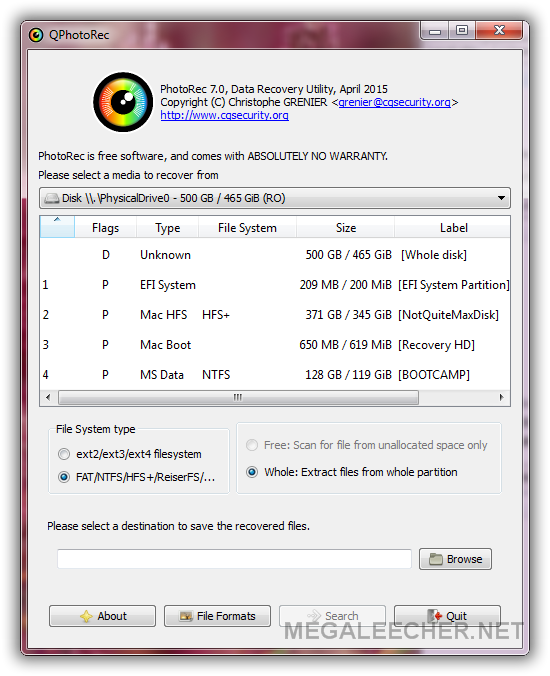

- #Photorec hfs file system archive#
- #Photorec hfs file system software#
- #Photorec hfs file system password#
zip zip archive including OpenOffice and MSOffice 2007 tif Tag Image File Format and some raw file formats (pef/nef/dcr/sr2/cr2) In FileOpts, enable or disable the recovery of certain file types, for example, Do not use this option unless absolutely necessary. It may be needed for large file systems that are heavily fragmented.
Enable Low memory if your system does not have enough memory and crashes during recovery. Enable Keep corrupted files to keep files even if they are invalid in the hope that data may still be salvaged from an invalid file using other tools. original partitions are lost) or a reformated partition, if PhotoRec has found very few files, you may want to try the minimal value that PhotoRec let you select (it's the sector size) for the block size (0 will be used for the offset). 
Each filesystem has his own block size (a multiple of the sector size) and offset (0 for NTFS, exFAT, ext2/3/4), these value are fixed when the filesystem has been created/formated.
The expert mode option allows the user to force the file system block size and the offset. Allow partial last cylinder modifies how the disk geometry is determined - only non-partitioned media should be affected. Paranoid By default, recovered files are verified and invalid files rejected.Įnable bruteforce if you want to recover more fragmented JPEG files, note it is a very CPU intensive operation. File Opt to modify the list of file types recovered by PhotoRec. Search after selecting the partition that holds the lost files to start the recovery,. If available, use the raw device, /dev/rdisk* instead of /dev/disk* for faster data transfer. Use up/down arrow keys to select the disk that holds the lost files. 
To recover files from other devices, run photorec device.įorensics users can use the parameter /log to create a log file named photorec.log it records the location of the files recovered by PhotoRec.Īvailable media are listed.
#Photorec hfs file system software#
Most devices should be autodetected including Linux software RAID (that is, /dev/md0) and file system encrypted with cryptsetup, dm-crypt, LUKS or TrueCrypt (ie.
photorec '/cygdrive/d/evidence/image.?' if the Encase image is split into several files in the directory d:\evidence. photorec 'image.?' if the Encase image is split into several files. photorec image.E01 to recover files from an Encase EWF image. photorec image.dd to carve a raw disk image. Under OS/2, PhotoRec doesn't handle physical devices, only disk images. #Photorec hfs file system password#
Sudo will ask for a password - enter your Mac OS X user password. If you are not root, PhotoRec will restart itself using sudo after a confirmation on your part.
Under Mac OS X, start PhotoRec (ie testdisk-6.13/photorec). Under Unix/Linux/BSD, you need to be root to run PhotoRec (ie. Under Windows Vista or later, right click photorec_win.exe and then click Run as administrator to launch PhotoRec. Under Windows, start PhotoRec (ie testdisk-6.13/photorec_win.exe) from an account in the Administrator group. To recover files from hard disk, USB key, Smart Card, CD-ROM, DVD, etc., you need enough rights to access the physical device. 
Extract the files from the archive including the sub-directories. If PhotoRec is not yet installed, it can be downloaded from TestDisk Download.
8 Select where recovered files should be written. 7 Carve the partition or unallocated space only.








 0 kommentar(er)
0 kommentar(er)
